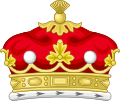This article needs additional citations for verification .(July 2015) |
| Marquessate of Linlithgow | |
|---|---|
  Arms of Hope: Azure, on a chevron or between three bezants a laurel leaf vert | |
| Creation date | 23 October 1902 |
| Created by | King Edward VII |
| Peerage | Peerage of the United Kingdom |
| First holder | John Hope, 7th Earl of Hopetoun |
| Present holder | Adrian Hope, 4th Marquess of Linlithgow |
| Heir apparent | Andrew Hope, Earl of Hopetoun |
| Remainder to | the 1st Marquess' heirs male of the body lawfully begotten |
| Subsidiary titles | Earl of Hopetoun Viscount Aithrie Lord Hope Baron Hopetoun Baron Niddry |
| Seat | Hopetoun House |
| Motto | At spes non fracta ("But my hope is not broken") |
Marquess of Linlithgow, in the County of Linlithgow or West Lothian, is a title in the Peerage of the United Kingdom. It was created on 23 October 1902 for John Hope, 7th Earl of Hopetoun. [1] The current holder of the title is Adrian Hope.
Contents
- Earls of Hopetoun (1703)
- Marquesses of Linlithgow (1902)
- Baron Niddry (1814)
- Family tree and line of succession
- Other family members
- See also
- Notes
- References
- External links
This branch of the Hope family descends from Sir Charles Hope, grandson of Sir James Hope, sixth son of Sir Thomas Hope, 1st Baronet, of Craighall (see Hope baronets). In 1703 he was created Lord Hope, Viscount Aithrie and Earl of Hopetoun in the Peerage of Scotland, with remainder to the heirs male and female of his body. He later served as Lord Lieutenant of Linlithgowshire and as Governor of the Bank of Scotland. Lord Hopetoun married Lady Henrietta, only surviving daughter of William Johnstone, 1st Marquess of Annandale (died 1721). He was succeeded by his eldest son, the second Earl. In 1763 he succeeded his kinsman as fourth Baronet, of Kirkliston (see Hope baronets for earlier history of this title).
His son from his first marriage, the third Earl, served as Lord Lieutenant of Linlithgowshire from 1794 to 1816 and sat in the House of Lords as a Scottish representative peer from 1784 to 1794. In 1792 Lord Hopetoun succeeded his great-uncle as de jure fifth Earl of Annandale and Hartfell, although he never successfully claimed this title. In 1809 he was created Baron Hopetoun, of Hopetoun in the County of Linlithgow, in the Peerage of the United Kingdom, with remainder to the heirs male of his father. [2] He died without male issue and the claim the earldom passed to his daughter Lady Anne (see below and the Earl of Annandale and Hartfell for later history of this branch of the family). Lord Hopetoun was succeeded (in the barony of Hopetoun according to the special remainder) by his half-brother, the fourth Earl. He was a general in the army, sat as Member of Parliament for Linlithgow and served as Lord Lieutenant of Linlithgowshire. In 1814, two years before he succeeded in the earldom, he was raised to the Peerage of the United Kingdom in his own right as Baron Niddry, of Niddry Castle in the County of Linlithgow. [3]
He was succeeded by his son, the fifth Earl. He was Lord Lieutenant of Linlithgowshire. His son, the sixth Earl, also served as Lord Lieutenant of Linlithgowshire. He was succeeded by his son, the seventh Earl. He was a prominent colonial administrator and Conservative politician and served as Governor of Victoria, as the first Governor-General of Australia and as Secretary of State for Scotland. In 1902 he was created Marquess of Linlithgow, in the County of Linlithgow or West Lothian. [4] His son, the second Marquess, was also a politician and served as Viceroy of India from 1936 to 1943. He was succeeded by his eldest twin son, the third Marquess. He was Lord Lieutenant of West Lothian from 1964 to 1985. As of 2013 [update] the titles are held by his only son, the fourth Marquess, who succeeded in 1985.
The family seat is Hopetoun House, near Queensferry, West Lothian.
